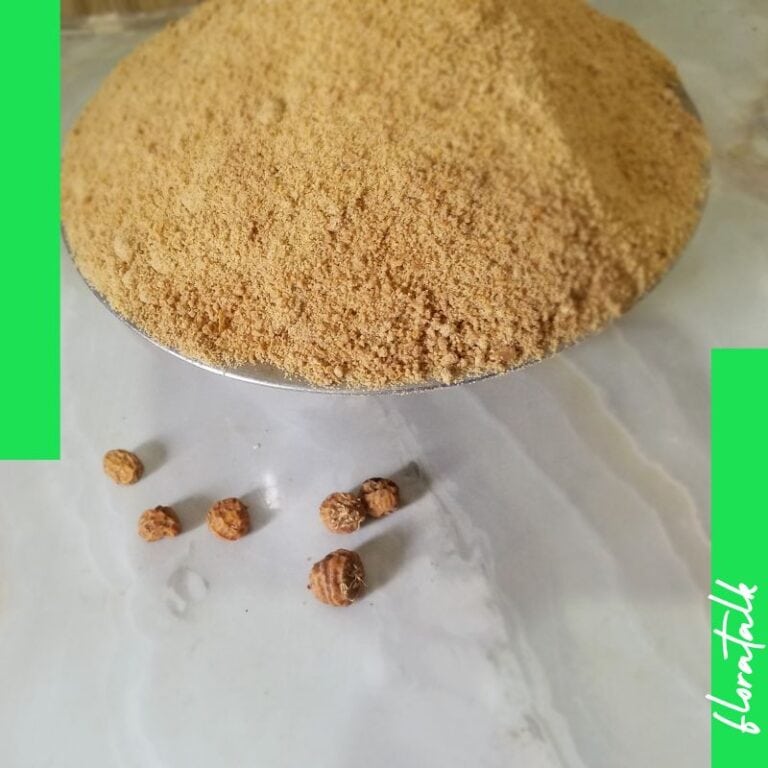Tiger Nuts: Simple Facts, Uses And Benefits To Know.

I look like a nut but am actually a tuber what am I? TIGER NUT
We begin a new series looking at tiger nuts
In this series we’ll cover:
- General knowledge on tiger nut,
- How to plant tiger nut,
- Tiger nut milk,
- Tiger nut flour and some recipes
- Tiger nut oil.
I admonish you follow through the whole series,
If you have anything on the subject you would like us to write about do share on the comment box below.
So what’s tiger nut;
Description
The tuber is a small rounded crop, the outer skin is yellow with brown or black stripes.
This pattern is similar to that of a tiger’s skin hence the name “tiger nut”
It’s white on the inside when cut into half.
The size of the tuber ranges from 7 mm – 20 mm in diameter.
It has a sweet – nutty taste.
Its botanical name is Cyperus Esculentus and it belongs to the Sedge family.
It is a perennial crop.
The tuber is sometimes referred to as a superfood.
Brief History
The crop has been in existence since ancient Egypt, it was a regular staple for Egyptian farmers at that time.
It was used for food and medicinal purposes,
Today, in different countries around the world the tuber is present.
Tiger Nut In Nigeria
Tiger nuts can be found all year round in Nigeria.
This crop is grown in every part of Nigeria.
They are grown much more in commercial quantities in northern Nigeria (Sokoto, Plateau, Kano, Katstina, Taraba).
The crop is usually exported to other countries from Nigeria.
In Nigeria tiger nuts can be found in malls, open markets, and street kiosks.
The Many Names of Tiger Nut
The crop known with various names, some location specific
Some of the names by which the crop is called are:
In Nigeria
- Igbo – Aki Awusa
- Hausa – Aya
- Yoruba – Ofio
- Efik – Isipaccara
Other Countries
- Spain- Chufa
- Germany – Chew-Fa
- South Africa – Zulu Nuts
- Egypt – Habel-Aziz
Other names are
- Yellow Nut Grass,
- Ground Almond
- Yellow Nutsedge
- Earth Almond
- Rush Nut
Types
The various varieties are identified by their colour and further grouped into different sizes (big and small).
Tiger nut comes in three varieties:
- Yellow
- Brown and
- Black
In Nigeria the common variety is the yellow and brown tiger nut.
Nutritional Information
Proximate composition of fresh tiger nuts per 100 grams.
| Carbohydrate | 17.82% |
| Fiber | 13.10% |
| Fat | 17.00% |
| Protein | 8.51% |
| Ash | 1.18% |
| Moisture Content | 42.40% |
| Magnesium | 118.14 mg |
| Potassium | 267.18 mg |
| Phosphorus | 158.86 mg |
| Calcium | 43.36 mg |
| Sodium | 17.02 mg |
| Copper | 0.54 mg |
| Iron | 2.82 mg |
| Zinc | 1.39 mg |
| Vitamin A | 0.87 mg |
| Vitamin C | 30.70 mg |
Source: Research Article – Clinical Investigation (2018) Volume 8, Issue 4)
Uses of Tiger Nut
Tiger nut used for different purposes in various industries
Food (Home and Industrial) Use:
For cooking, baking, roasting, grilling and taken fresh as a snack or processed snacks like Tiger nut sticks, Dakuwa
Further processing of the nut into
Oil: The oil used for cooking, baking and also used for other industrial uses.
Milk: Tiger nut milk is a plant based milk, a healthy replacement of dairy milk
Flour: Tiger nut flour is also produced from the tuber
The flour is an alternative to baking flour in some recipes to make cookies, bread etc.
The flour serves as a thickener.
It is further processed to make other meals like tiger nut pap, beverages, drink (Kunu Aya), and juice.
Confectionery: used for flavour and sweetener in ice cream, fruit juice and biscuit
Starch is make from the tuber as well,
Used to make Tiger nut yogurt.
Cosmetics: Used in soap making and other skin care products.
Animal feed: it used to feed live stocks,
Poultry birds are not left out; they feed on from the chaff after making tiger nut milk, which you can feed them with at home.
Usually mixed with maize to produce feed for catfish.
Health Benefits of Tiger Nuts
Here are some of the benefits of adding tiger nut a diet
Energy:
Tiger nut has an energy value of 100 cal /100 g this makes it an excellent energy drink when taking the milk.
Cancer risk reduction:
Help reduce the risk of colon cancer.
Helps with a healthy urinary tract:
It helps with urine production, and help in the prevention of urinary tract infection,
Very potent in treating infection.
Beneficial to the digestive system:
The high fiber content helps prevent constipation and promotes bowel movement,
It also produces digestive enzymes that help with flatulence, dysentery and diarrhea.
Good for the hearts health:
This is how the tuber helps your heart and,
helps to reduce bad cholesterol thereby increasing the good cholesterol,
and it also activates blood circulation.
Helps boost immunity:
The tuber’s ability to fight infection and bacteria makes it good at improving our immune system.
High in nutrients:
From the nutritional facts above you can see the nutritional composition,
Eating the tuber as snacks, drink whichever way it’s consumed, its nutritious and good for the body.
Good for healthy blood sugar level:
The tuber when taken without sweetener is good for diabetics,
The presence of arginine in the nuts helps improve insulin sensitivity and production; this helps to promote healthy blood sugar level.
Promotes healthy reproductive health:
Promotes menstruation, it improves sexual drive, thus known as an aphrodisiac (anything that stimulates sexual desire).
Good for the skin:
The oil contains enough vitamin E which is good for the skin.
Healthy bones and teeth:
It has high calcium content which makes it good for the bones and teeth.






